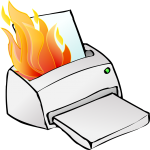As you progress in the electrical trade, you will hear and learn many terms or jargon being tossed around.
Getting a firm understanding of all of them can take years.
Lucky for you, we’ve put together the most common electrical terms you’ll need to know in your career as an electrician.
Electrical Terms For Circuits
Alternating Current (AC) – an electric current reserving its directions multiple times per second at regular intervals.
Direct Current (DC) – an electric current flowing only in one direction.
Feeder – all circuit conductors between the service equipment, a source of a system derived separately, or another power source and the final overcurrent branch-circuit device.
Fuse – a circuit interrupting device that consists of a wire strip that melts and the electric circuit is broken if the current is above a safe level.
The fuse should be replaced with a similar one of the same size and rating to restore service after the cause of failure is corrected.
Earth or ground – the reference point in a circuit from which the voltages are measured, or a physical connection to the Earth.
It’s also a return path for electric current.
Ground fault – an erratic conductive connection between an electrical circuit ungrounded conductor and the non-current-carrying conductors, metallic equipment, enclosures, raceways, or earth.
Grounded conductor – a circuit conductor or system that is grounded intentionally.
Grounded (grounding) – connected or connecting to the ground or a conductive body extending the ground connection.
Ground-fault current path – an electrically conductive path from a ground fault point on a wiring system through typically non-current-carrying equipment, conductors, or the earth to the electrical source.
Load – any device consuming electrical energy, such as heaters, electric motors, lights, transformers, etc.
Neutral conductor – the conductor which is connected to the system’s neutral point intended to run current under normal conditions.
Overload – work of equipment in excess of full-load normal rating, or of a conductor with exceeded rated ampacity that can cause damage or overheating if it resists for a long time.
A short circuit or ground fault isn’t an overload.
Parallel circuit – a circuit with multiple paths for the flow of electricity.
Every load is connected in a separate path and receives the full voltage.
The total current equals the sum of the separate branch currents.
Rectifier – an electrical device converting AC to DC by directing the current through it in only one direction.
Series circuit – a circuit with only one path of electrical flow.
The current in a circuit should flow through all the loads, closing its path to the source of supply.
Series parallel circuit – an electric current with groups of parallel-connected receptive devices, which are arranged in series.
Short circuit – a defect in an electric apparatus or circuit usually caused by imperfect insulation.
So, the current follows a by-path causing damage or being wasted.
Electrical Terms for Components
Ammeter – a device measuring the current flow in a circuit in amperes.
An ammeter is connected in the circuit in series.
Arc fault circuit interrupter (AFCI) – a type of circuit breaker or receptacle that opens the circuit when detecting a dangerous electrical arc.
Its purpose is to prevent electrical fires.
Capacitor – a passive two-terminal component temporarily storing electrical energy in an electric field.
Circuit – a closed path with the flow of electrons from a current or voltage source.
Circuits can be in parallel, in series, or a combination of the two.
Circuit breaker – an automatic device used for stopping the current flow in a circuit.
It should be reset (closed) to restore service after fixing the overload or failure cause.
Conductor – any type of material through which electric current can freely flow.
Conductive materials (e.g. metals) have low resistance.
The most common conductors are aluminum or copper wires.
Digital multimeter (DMM) – an electronic measurement device with the capacity to measure current, voltage, temperature, capacitance, resistance, and frequency.
Diode – a two-terminal semiconductive device that allows the current to flow in only one direction.
Generator – a device converting mechanical energy to electrical to be used in an external circuit.
There can be various sources of mechanical energy, from hand cranks to internal combustion engines.
Almost all power for electric grids is provided by generators.
Ground fault circuit interrupters (GFCI) – a device for personnel protection that works on de-energizing the circuit or its portion during a specific time when a current to ground is in excess of a predetermined value, which is less than required for the operation of the overcurrent protective device of the supply circuit.
Inverter – a device converting DC into AC.
Insulator – a material that prevents electric current from flowing freely.
Insulation material can be glass, air, rubber, or plastic with high resistance.
Insulators are used to protect life and equipment from an electric shock.
Service – the equipment and conductors delivering energy from the electrical supply system to the served system.
Service lateral – service conductors placed underground connecting the street main and the first connection point to the service-entrance conductors in a meter, terminal box, or other enclosure.
Semiconductor – a solid substance with conductivity features of an insulator and most metals, either because of temperature effects or the addition of an impurity.
Semiconductor-based devices, such as silicon, are significant parts of most electronic circuits.
Solid state relay (SCR) – an electronic switcher that switches on or off with a small external voltage being applied across control terminals.
The switching is notably fast.
Solenoid – a spiral of conductive wire that turns off, which is almost equal to a succession of parallel circuits when an electric current passes through it.
It gains magnetic features similar to a magnet bar.
Switch – a device used for breaking, making, or changing the connections in an electric current.
Switchgear – a succession of electrical disconnect fuses, switches, or circuit breakers controlling, isolating, and protecting electrical equipment.
It is used for de-energizing equipment for the work to be done and for clearing faults downstream.
Transistor – a semiconductor three-connection device used for rectification and amplification.
Electrical Terms for Mathematical Calculations
Apparent power – the product of the RMS current and RMS voltage, which is measured in volt-amperes (VA).
Ampere (A) – an intensity measurement unit of an electric current in a circuit.
One ampere is equal to a flow of the current of one coulomb per second.
Capacitance – the capacity of a body for electrical charge storage.
It is measured in farads as the ratio of an object’s electric charge (coulombs, Q) to the voltage across the entire object (volts, V).
Current (I) – the electric charge flows through a conductor.
An electric current is measured in amperes and can be compared to the water flow in a pipe.
Demand – the average power value or related quantity over a certain time.
Farad – a capacitance measure unit.
One farad is equal to one coulomb per volt.
Frequency – the cycle number per second, which is measured in Hertz (Hz).
One cycle per second completed by a current has a frequency of 1Hz; 60 cycles are equal to 60 Hz.
Henry (H) – inductance measure unit.
If the current change rate in a circuit is 1A per second and the output of the electromotive force is 1V, the circuit inductance is 1H.
Hertz (Hz) – frequency measurement unit.
A replacement for the term cycle per second (CPS).
Impedance (Z) – the effective electric circuit or component resistance to AC, which rises from the combined effect of reactance and ohmic resistance.
Inductance – the conductor’s property by which the change of current that flows through it induces (creates) electromotive force, or voltage, in the conductor (a.k.a. self-inductance) and nearby conductors (a.k.a. mutual inductance).
The measurement unit is henry (H).
Kilowatt-hour (kWh) – the result of kW of power and time in hours, which equals 1000 watt-hour.
For example: if a light bulb of 100W is used for 4 hours, it equals 0.4kWh of used energy (100W x 1kW / 1000 watts x 4 hours).
Kilowatt-hour meter – a device for electrical energy use measurement.
Kilowatt (kW) – equals to 1000 watts.
Ohm (Ω) – a resistance measurement unit.
One ohm is equivalent to the resistance in a circuit that transmits a current of 1A when in the scope of potential difference on 1V.
Ohm’s law – the math equation explaining the relation between voltage, current, and resistance (V=IR).
Power – the rate of electrical energy transfer by an electric circuit, which is measured in watts.
Reactive power – the electricity portion that sustains and establishes the magnetic and electric field of AC equipment.
It exists in an AC circuit when the voltage and current aren’t in phase.
The measurement unit is volt-ampere reactive (VARs).
Resistance – the passage of an electric current opposition.
Electrical resistance is compared to the friction that happens to water when it’s flowing through a pipe.
The measurement unit is the ohm (Ω).
True power – the power in a tangible form such as acoustic waves, electromagnetic radiation, or mechanical phenomena, which is measured in Watts.
The voltage and current are on phase in a DC or AC circuit with pure resistance.
Volt-ampere reactive (VARs) – the measurement unit of reactive power.
It’s considered as the imaginary part of apparent power or as the power flowing into the reactive load.
The current and voltage are specified in amperes and volts.
Volt-ampere (VA) – measurement unit of apparent power, which is the product of RMS current and RMS voltage.
Volt (V) – measurement unit of voltage.
One volt is equal to the difference of potential driving 1A current against 1Ω resistance.
Voltage (E) – “pressure” or electromotive force, making electrons flow that can be compared to the pressure of water which makes it flow in a pipe.
The measurement unit is volts (V).
Watt-hour (Wh) – electrical energy unit equivalent to the power consumption of one watt per hour.
Watt (W) – electrical power unit.
One watt is one joule per second.
It corresponds to the power in a circuit with the potential difference of 1V and 1A current.
Electrical Terms For Conduit Bending
Hand bender – a tool for bending electrical metal tubing (EMT), rigid metal conduit (RMC), and intermediate metal conduit (IMC).
These tools are of sizes 1/2″, 3/4″, 1″, and 1-1/4″.
Four bend saddle – a piece of a conduit of four bends clearing an obstacle by saddling it.
Offset – a bend in conduit used for clearing an obstacle, usually only two bends.
Three bend saddle – a piece of a conduit of three bends with one in the center and two on the sides
It’s used to clear an obstacle by saddling it.
Gain – the difference between the sum of the actual length of the conduit and the sum of the straight distances.
Shrink – the conduit will shrink due to bending around an obstruction.
It is added to the entire distance of obstruction for compensation before bending.
Multiplier – a tool for calculating the distance between bends with “multiplier X offset”.
Random Electrical Terms That You Should Be Familiar With
Arc flash – is heat and light and is a type of discharge or electrical explosion resulting from a low-impedance connection through the air to ground or another voltage phase.
The temperatures can reach 35,000 °F.
Arc blast – the intense heat from the arc can cause an expansion of air which can result in a blast.
During an arc flash event, copper expands at a factor of 67000 times in milliseconds.
Calorie – the French heat unit, which is used for energy levels measurement for arc flash boundaries and PPE during the work on energized electrical equipment.
Construction electrician (CE) – performs basic duties with little or zero supervision.
They can’t supervise others or act as a foreman.
This page is also available in Spanish.










